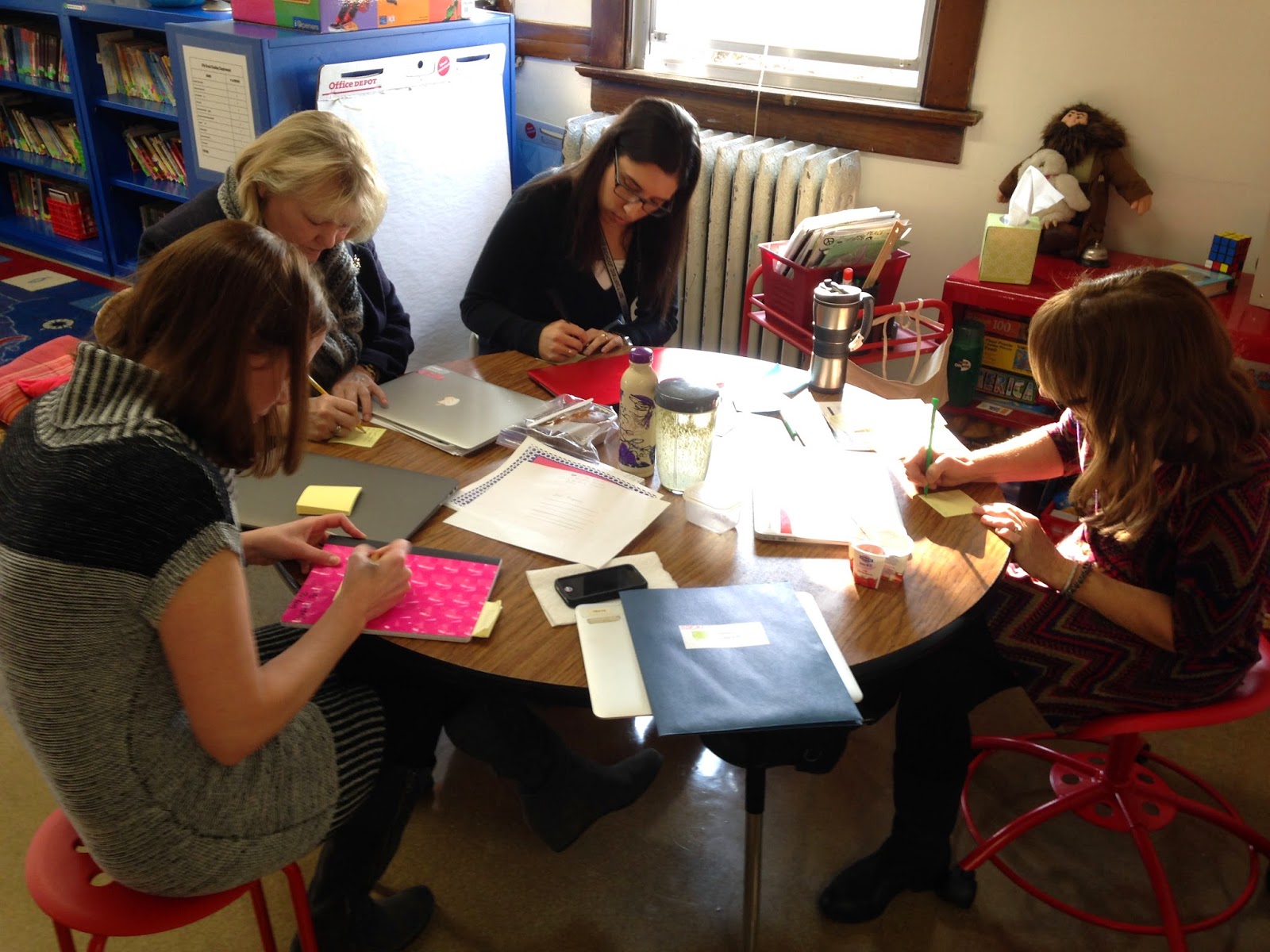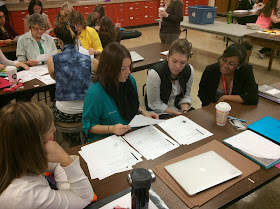Last week, I wrote a post about our staff using the narrative writing standard of the common core and annotating evidence of it on grade level exemplar samples, provided by the Lucy Calkins Units of Study. You can find that post here.
Jane DeCaire and I had done that activity to help up get ready for a task that had been assigned by our district Writing Core group. They had asked that every school pick exemplars of their narrative writing so that we can group them and look at samples from across the district. In order to do that, we felt that we had to familiarize ourselves with grade level expectations. All too often, we compare the samples in the room with the other samples in the room, and pick soley based on comparing them to each other. By looking at the standard and a grade level sample (most of which were more developed than our kids produce), we began to see where the "bar" is.
For this week, we brought some of our student writing and had the teachers look for evidence of the standard in those samples, and determine what were samples that meet the standard, and if we had any that exceed. In a previous meeting, we had used these terms to sort work into categories:
1: Below
2: Approaching the standard
3: Meeting the standard
4: Exceeding
We had asked our staff to bring the top 3 samples from their class. So, is the work they brought a 3 or a 4?
That seemed to be the question that arose. We are just getting our feet in the water with standards based grading, and our report cards do not necessarily match the work we are beginning to do with our staff. So, in my opinion, it comes down to our PURPOSE for grading in the first place. The great Bob Marzano wrote about it in his book, Transforming Classroom Grading. Here is a link to a piece of it about purpose for grading.
He names 5 purposes:
1. Administrative purposes (promotion, retention, class rank, etc.)
2. Feedback about student achievement (one of the typical primary purposes of grading)
3. Guidance (guidance for choosing placement, like a guidance counselor would do)
4. Instructional Planning (to help determine groups and instructional plans)
5. Motivation (for the students)
So which is most important? Marzano said, "In short, there is no clear pattern of preference across the various sources except for the importance of feedback. Consequently, schools and districts must undertake their own studies of teachers and administrators regarding the purpose of grades." Hey, he must be eavesdropping at our meetings! :)
Back to that "Is it a three, or is it a 4?" question... It depends a bit on our purpose at Hiawatha. If we are using that 3 or 4 to show whether our students should promote to the next grade, or be retained, then we really need to know what a three or a four is. Our report cards are not there yet as a district, though, and that is a conversation that really should be held district wide.
What if our purpose is feedback about student achievement? If we look at student work to see if they achieved the learning goals of our lesson, then it is also important to really know what would be considered a 3 or a 4. If the majority of the class does not get that 3 or 4, should we then use the information to plan for instruction and revisit the missing concepts? But, if we don't have a clear understanding of what a 1, 2, 3, or 4 really mean, it could be possible for kids in one class to get a 4, and kids in another class to get a 2, for doing relatively the same quality of work. How do we know what to reteach then?
What if our purpose of grading includes student motivation, but the 4 is marked for performing at the next grade's standard, and no one in the class can even perform at grade level? How does that affect motivation?
There are many, many, many questions that come up when we start to have conversations like the ones we are beginning to have at Hiawatha. I really think that all of those purposes for grading are relevant to our conversations as we begin a journey towards standards based grading. I think the most important factor right now is the collaboration of the grade level teams. The answer might be different if the task is a pre-assessment, a response journal, a writing sample, or a math problem. The fact that we are talking with each other, and trying to align our expectations, is critical.
So, here is a question for your team:
What was your learning goal for the lesson/ assessment/ unit? What did you expect for them to be able to do?
Perhaps that is your 3. And it is good to get a 3! The 4 really should be all that you expect in the 3, but go beyond what was taught to the whole class.
In short, here are some goals for us as we move forward:
1. Use the standards in the conversation. The more we reference the standards and talk about them as a team, the more we understand their potential impact on our kids.
2. Know that we are in the early stages of this process. It is OK if, for now, we use this process to just help us decide what to teach next. It does not have to be about report cards right now.
3. Get to know your kids and what they can do. Move them along to where they can go.
4. Give yourself permission to figure out your learning goals/ targets and then communicate those to your students with student friendly checklists. (More on that soon!)
5. Use our conversations to give better feedback to your students, and less to grade them.
Thank you, Hiawatha staff, for starting on this journey!







































